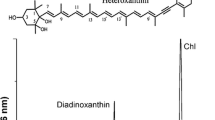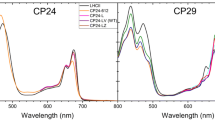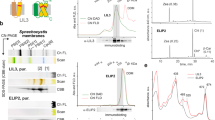Abstract
The Porphyridium cruentum light harvesting complex (LHC) binds Chl a, zeaxanthin and β-carotene and comprises at least 6 polypeptides of a multigene family. We describe the first in vitro reconstitution of a red algal light-harvesting protein (LHCaR1) with Chl a/carotenoid extracts from P. cruentum. The reconstituted pigment complex (rLHCaR1) is spectrally similar to the native LHC I, with an absorption maximum at 670 nm, a 77 K fluorescence emission peak at 677 nm (ex. 440 nm), and similar circular dichroism spectra. Molar ratios of 4.0 zeaxanthin, 0.3 β-carotene and 8.2 Chl a per polypeptide for rLHCaR1 are similar to those of the native LHC I complex (3.1 zeaxanthin, 0.5 β-carotene, 8.5 Chl a). The binding of 8 Chl a molecules per apoprotein is consistent with 8 putative Chl-binding sites in the predicted transmembrane helices of LHCaR1. Two of the putative Chl a binding sites (helix 2) in LHCaR1 were assigned to Chl b in Chl a/b-binding (CAB) LHC II [Kühlbrandt et al. (1994) Nature 367: 614–21]. This suggests either that discrimination for binding of Chl a or Chl b is not very specific at these sites or that specificity of binding sites evolved separately in CAB proteins. LHCaR1 can be reconstituted with varying ratios of carotenoids, consistent with our previous observation that the carotenoid to Chl ratio is substantially higher in P. cruentum grown under high irradiance. Also notable is that zeaxanthin does not act as an accessory light-harvesting pigment, even though it is highly likely that it occupies the position assigned to lutein in the CAB LHCs.
Similar content being viewed by others
References
Aizawa K, Cunningham FX, Jr and Gantt E (1997) Enhanced recovery of chlorophyll and carotenoids with dextran-polyacrylamide gel electrophoresis. Analytical Sci 13: 253–256
Bassi R, Croce R, Cugini D and Sandona D (1999) Mutational analysis of a higher plant antenna protein provides identification of chromophores bound into multiple sites. Proc Natl Acad Sci USA 96: 10056–10061
Büchel C and Garab G (1997) Organization of the pigment molecules in the chlorophyll a/c light-harvesting complex of Pleurochloris meiringensis (xanthophyceae). Characterization with circular dichroism and absorbance spectroscopy. J Photochem Photobiol B:Biol 37: 118–124
Cammarata KV and Schmidt GW (1992) In vitro reconstitution of a light-harvesting gene product: Deletion mutagenesis and analyses of pigment binding. Biochemistry 31: 2779–2789
Cammarata KV, Plumley FG and Schmidt GW (1992) Pigment and protein composition of reconstituted light-harvesting complexes and effects of some protein modifications. Photosynth Res 33: 235–250
Chamovitz D, Sandmann G and Hirschberg J (1993) Molecular and biochemical characterization of herbicide resistant mutants of cyanobacteria reveals that phytoene desaturation is a ratelimiting step in carotenoid biosynthesis. J Biol Chem 268: 17348–17353
Cunningham FX Jr, Dennenberg RJ, Mustardy L, Jursinic PA and Gantt E (1989) Stoichiometry of Photosystem I, Photosystem II, and phycobilisomes in the red alga Porphyridium cruentum as a function of growth irradiance. Plant Physiol 91: 1179–1187
Davies BH (1976) Carotenoids. In: Goodwin TW (ed) Chemistry and Biochemistry of Plant Pigments, 2nd ed, Vol 2, pp 38–165. Academic Press, London/New York
Delwiche C, Kuhsel M and Palmer JD (1995) Phylogenetic analysis of tufA sequences indicates a cyanobacterial origin of all plastids. Mol Phylogen and Evol 4: 110–128
Durnford DG, Deane JA, Tan S, McFadden GI, Gantt E and Green BR (1999) A phylogenetic assessment of the eukaryotic light-harvesting antenna proteins, with implications for plastid evolution. J Mol Evol 48: 59–68
Duysens LNM (1952) Transfer of excitation energy in photosynthesis. PhD thesis, University of Utrecht, The Netherlands
Gantt E (1986) Phycobilisomes. In: Staehelin LA and Arntzen CJ (eds) Encyclopedia of Plant Physiology: Photosynthesis III, Vol 19, pp 260–268. Springer-Verlag, Berlin
Gantt E, Cunningham FX, Jr, Grabowski B and Tan S (1998) Relatedness of caroteno-chlorophyll antenna complexes in algae and plants. In: Garab G (ed) Photosynthesis: Mechanisms and Effects, Vol 1, pp 239–247. Kluwer Academic Publishers, Dordrecht, The Netherlands
Giuffra E, Cugini D, Croce R and Bassi R (1996) Reconstitution and pigment-binding properties of recombinant CP29. Euro J Biochem 238: 112–120
Green BR and Durnford DG (1996) The chlorophyll-carotenoid proteins of oxygenic photosynthesis. Ann Rev of Plant Physiol and Plant Mol Biol 47: 685–714
Green BR and Kühlbrandt W (1995) Sequence conservation of light-harvesting and stress-response proteins in relation to the 3-dimensional molecular-structure of LHC II. Photosynth Res 44: 139–148
Hobe S, Förster R, Klingler J and Paulsen H (1995) N-Proximal sequence motif in light-harvesting chlorophyll a/b-binding protein is essential for the trimerization of light-harvesting chlorophyll a/b complex. Biochemistry 34: 10224–10228
Ide JP, Klug DR, Kühlbrandt W, Giorgi LB and Porter G (1987) The state of detergent solubilised light-harvesting chlorophylla/ b protein complex as monitored by picosecond time-resolved fluorescence and circular dichroism. Biochim Biophys Acta 893: 349–364
Ikeuchi M, Hirano A and Inoue Y (1991) Correspondence of apoproteins of light-harvesting Chl a/b complexes associated with Photosystem I to cab genes: Evidence for a novel type IV apoprotein. Plant Cell Physiol 32: 103–112
Jeffrey SW, Mantoura RFC and Bjørnland (1997) Data for the identification of 47 key phytoplankton pigments. In: Jeffrey SWet al. (eds) Phytoplankton Pigments in Oceanography, pp 449–559. UNESCO Publishing
Jones RH, Speer HL and Curry W (1963) Studies on the growth of the red alga Porphyridium cruentum. Physiol Plant 20: 697–705
Kühlbrandt W, Wang DN and Fujiyoshi Y (1994) Atomic model of plant light-harvesting complex by electron crystallography. Nature 367: 614–621
Kuttkat A, Harmann A, Hobe S and Paulsen H (1996) The Cterminal domain of light-harvesting chlorophyll-a/b-binding protein is involved in the stabilisation of trimeric light-harvesting complex. Eur J Biochem 242: 288–292
Laemmli UK (1970) Cleavage of structural proteins during the assembly of the head of bacteriophage T4. Nature 227: 680–685
Marquardt J and Rhiel E (1997) The membrane-intrinsic lightharvesting complex of the red alga Galdieria sulphuraria (formerly Cyanidium caldarium): Biochemical and immunochemical characterization. Biochim Biophys Acta 1320: 153–164
Moran R (1982) Formulae for determination of chlorophyllous pigments extracted with N,N-dimethylformamide. Plant Physiol 69: 1376–1381
Niyogi KK, Björkman O and Grossman AR (1997) Chlamydomonas xanthophyll cycle mutants identified by video imaging of chlorophyll fluorescence quenching. Plant Cell 9: 1369–1380
Oakley BR, Kirsch DR and Morris NR (1980) A simplified ultrasensitive silver stain for detecting proteins in polyacrylamide gels. Analyt Biochem 105: 361–363
Paulsen H and Hobe S (1992) Pigment-binding properties of mutant light-harvesting chlorophyll-a/b-binding protein. Eur J Biochem 205: 71–76
Paulsen H, Rumler U and Rudiger W (1990) Reconstitution of pigment-containing complexes from light-harvesting chlorophyll a/b-binding protein overexpressed in Escherichia coli. Planta 181: 204–211
Peluso RW and Rosenberg GH (1987) Quantitative electrotransfer of proteins from sodium dodecyl sulfate-polyacrylamide gels onto positively charged nylon membranes. Analyt Biochem 162: 389–398
Plumley FG and Schmidt GW (1987) Reconstitution of chlorophyll a/b light-harvesting complexes: Xanthophyll-dependent assembly and energy transfer. Proc Natl Acad Sci USA 84: 146–150
Pogson B, McDonald KA, Truong M, Britton G and DellaPenna D (1996) Arabidopsis carotenoid mutants demonstrate that lutein is not essential for photosynthesis in higher plants. Plant Cell 8: 1627–1639
Porra RJ (1991) Recent advances and re-assessments in chlorophyll extraction and assay procedures for terrestrial, aquatic, and marine organisms, including recalcitrant algae. In: Scheer H (ed) Chlorophylls, pp 31–57. CRC Press, Boca-Raton, Florida
Rogl H, Lamborghini M and Kühlbrandt W (1998) Chlorophyll exchange on reconstituted LHC II: Chlorophyll a is essential for trimerisation. In: Garab G (ed) Photosynthesis: Mechanisms and Effects, Vol I, pp 361–364. Kluwer Academic Publishers, Dordrecht, The Netherlands
Rowan KS (1989) Photosynthetic Pigments of Algae. Cambridge University Press, Cambridge
Shepanski JF and Knox RS (1981) Circular dichroism and other optical properties of antenna chlorophyll proteins from higher plants. Israel J Chem 21: 325–331
Schmid VHR, Cammarata KV, Bruns BU and Schmidt GW (1997) In vitro reconstitution of the Photosystem I light-harvesting complex LHC I-730: Heterodimerization is required for antenna pigment organization. Proc Natl Acad Sci USA 94: 7667–7672
Siefermann-Harms D (1985) Carotenoids in photosynthesis. I. Location in photosynthetic membranes and light-harvesting function. Biochim Biophys Acta 811: 325–355
Simpson DJ and Knöetzel J (1996) Light-harvesting complexes in plants and algae: Introduction, survey, and nomenclature. In: Ort D and Yocum CF (eds) Oxygenic Photosynthesis: The Light Reactions, pp 493–506. Kluwer Academic Publishers, Dordrecht, The Netherlands
Smith PK, Krohn RI, Hermanson GT, Mallia AK, Gartner FH, Provenzano MD, Fujimoto EK, Goeke NM, Olson BJ and Klenk DC (1985) Measurement of protein using bicinchoninic acid. Analyt Biochem 150: 76–85
Stransky H and Hager A (1970) Das Carotinoidmuster und die Verbreitung des lichtinduzierten Xanthophyllcyclus inverschiedenen Algenklassen. IV. Cyanophyceae und Rhodophyceae. Arch Mikrobiol 72: 84–96
Tan S, Wolfe GR, Cunningham FX, Jr and Gantt E (1995) Decrease of polypeptides in the PS I antenna complex with increasing growth irradiance in the red alga Porphyridium cruentum. Photosynth Res 45: 1–10
Tan S, Cunningham FXC, Jr and Gantt E (1997a) LHCaR1 of the red alga Porphyridium cruentum encodes a polypeptide of the LHC I complex with seven potential chlorophyll a-binding residues that are conserved in most LHCs. Plant Mol Biol 33: 157–167
Tan S, Ducret A, Aebersold R and Gantt E (1997b) Red algal LHC I genes have similarities with both Chl a/b-and a/c-binding proteins: A 21 kDa polypeptide encoded by LhcaR2 is one of the six LHC I polypeptides. Photosynth Res 53: 129–140
Van Metter RL (1977) Excitation energy transfer in the lightharvesting chlorophyll a/b protein. Biochim Biophys Acta 462: 642–658
Wolfe GR, Cunningham FX Jr, Durnford D, Green BR and Gantt E (1994a) Evidence for a common origin of chloroplasts with lightharvesting complexes of different pigmentation. Nature 367: 566–568
Wolfe GR, Cunningham FX Jr, Grabowski B and Gantt E (1994b) Isolation and characterization of Photosystem I and II from the red alga Porphyridium cruentum. Biochim Biophys Acta 1188: 357–366
Author information
Authors and Affiliations
Corresponding author
Rights and permissions
About this article
Cite this article
Grabowski, B., Tan, S., Cunningham, F.X. et al. Characterization of the Porphyridium cruentum Chl a-binding LHC by in vitro reconstitution: LHCaR1 binds 8 Chl a molecules and proportionately more carotenoids than CAB proteins. Photosynthesis Research 63, 85–96 (2000). https://doi.org/10.1023/A:1006357107247
Issue Date:
DOI: https://doi.org/10.1023/A:1006357107247




